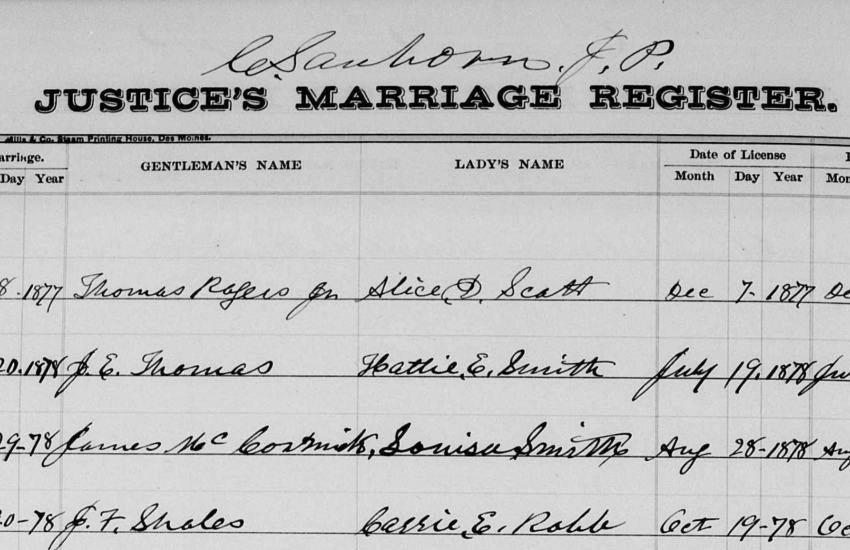Red herring: Wrong Hattie E. Smith
The case of the missing Iowa marriage records
I'll admit that Ancestry.com is my go-to research tool for finding vital records, especially U.S. records. I pay enough to have easy access, so why not make frequent use of its vast databases and helpful finding technologies.
Yes, but Ancestry is not perfect. No single record collection is an absolute standard. If a record does not surface in Ancestry, that does not mean that it does not exist in another genealogy collection.
For me, this came up recently while researching a Stetson family branch for our Minnesota Mix storyspace. Using Ancestry as my search tool, I easily located birth and death records for the parents and six children. However, there was no marriage record that turned up—not in Maine or Ohio, where Herbert Stetson and Hattie Smith had originated, or in Iowa, where they later raised a family.
For several days, I entertained various wild guesses about why there might not be a marriage record. Was it not a legal union? Did they actually meet in another state? But I forgot to search in genealogy services outside of my go-to resource. Finally it was a Google search that led me to the first place I should have gone to double-check the information: FamilySearch.org, the vast, non-profit genealogy resource sponsored by the LDS church.
And there I found the indexed record for the marriage recorded June 17, 1879 in the town of Earlville in Delaware County, Iowa. The record image was not available but a complete citation was given:
"Iowa, County Marriages, 1838-1934," database, FamilySearch (https://familysearch.org/ark:/61903/1:1:XJKS-GXJ : 10 February 2018), Herbert E. Stetson and Hattie E. F. Smith, 17 Jun 1879, Earlville, Delaware, Iowa, United States; citing reference Vol C Page 171, county courthouses, Iowa; FHL microfilm 1,035,392.
The information nicely fit with the known information, and supported a narrative of two schoolteachers who met in Iowa upon taking up new teaching jobs.
But why is it not available on Ancestry.com? In my experience, this is a very rare case when a vital record has shown up on another genealogy service when it is not on Ancestry.
Well, for starters, look at the names of the database collections. On Ancestry, it is Iowa, U.S., Marriage Records, 1880-1951. On FamilySearch, the Iowa marriage collection aggregates sources from 1809-1992, including this one: Iowa, County Marriages, 1838-1934.
Under source information for the Ancestry collection we learn the significance of the 1880 date: Civil registration of births, marriages, and deaths began 1 July 1880 in Iowa.
Before that time, records were kept in various formats in each Iowa county. Here is a further explanation from Iowa.gov:
The Iowa State Board of Health was established on July 1, 1880. During the first meeting, they created an Iowa Vital Records system of birth, death, and marriage record keeping. At the same time, registration responsibilities were not well defined, resulting in poor record keeping in some areas of the state. A few events, primarily marriages, were recorded in some counties prior to the 1880 date; however, little information is included on those records.
The marriage in question happened in June 1879, a year before the record keeping was standardized. That's why it is not in Ancestry's main Iowa marriage collection, but what about any earlier sources that Ancestry has access to?
Drilling down deeper into Ancestry's card catalog, we find several collections of compiled Iowa marriage records, including Iowa, U.S., Compiled Marriages, 1851-1900, which are described as "taken from microfilm copies of original county documents." This would possibly cover the marriage we're looking for. Except for this: The collection covers 21 Iowa counties, from Adair to Worth, but does not include Delaware County or its predecessor Dubuque County.
On the other hand, the FamilySearch county marriage catalog listing covers a more comprehensive set of Iowa counties, including this listing of Delaware County marriage record sources. The index is a part of a collection on nine microfilm reels of original county records from the Delaware County Courthouse that were filmed in 1980 and 1990 by the Genealogical Society of Utah
Several of the links look interesting but it is the main index listed with a link highlighted in red that has our record. Click it and search for Herbert Stetson or Hattie Smith to find the family marriage record.
When you do the search for Harriet you'll find two Hattie E. Hattie E. Smiths that married in Delaware County in the late 1870s. This sent me on an unfortunate detour into the possibility that Harriet could have had a previous annulled marriage. It took a few days until I could show that the two Hatties were different people.
Now, FamilySearch and Ancestry are not exactly competitors and in fact have a pretty wide-ranging record-sharing agreement. Yet here is a clear example of a significant record set where FamilySearch data is not available in Ancestry. Trying to learn why led me to this video, When You Can't Find a Marriage Record, by Ancestry evangelist Crista Cowan.
The video offers some useful search strategies and relevant concepts—particularly the importance of county formation in relation to state record collections. However, the video does not address the apparent issue I stumbled on. Down below in the comments, though, is one from Dorwin Black describing the same issue but regarding county marriage records from Ohio.
This suggests that there is a more general issue at work here that regular Ancestry users like me may not be aware of. I will put in a query to Ancestry about it and follow up here with any reply. Meanwhile, exercise caution with U.S. state marriage record queries on Ancestry. If in doubt, always do a backup search on other genealogy search sites, and especially on FamilySearch.org.

